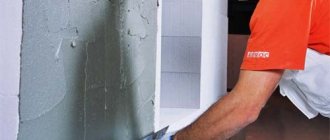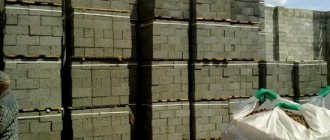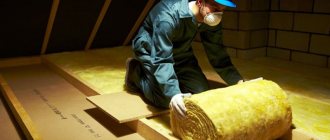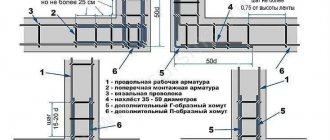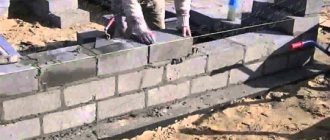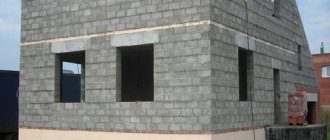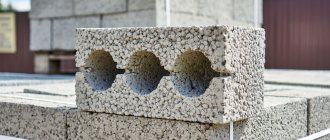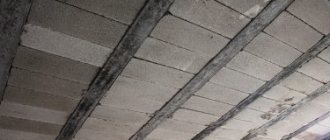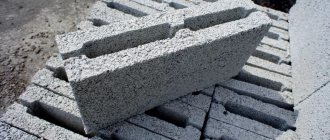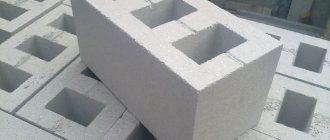Preface
. Even before the construction of an expanded clay concrete house begins, many developers ask the question: is it necessary to insulate walls made of 40 cm expanded clay blocks? It happens that the house has already been built, but the owners spend a lot of money on heating it. Then the question becomes relevant, what is the best way to insulate a house made of expanded clay block. In this article we will analyze both of these questions and show video instructions on how to insulate walls made of expanded clay concrete.
Expanded clay concrete blocks appeared on the construction market not long ago and many have not yet encountered them. This material is characterized by strength, durability, frost resistance and low thermal conductivity. Due to its increased strength characteristics, but at the same time with a low thermal conductivity coefficient, expanded clay blocks are in great demand.
The most important thing is that without high-quality thermal insulation of the walls, insulation of the strip foundation and basement, heating a house in the cold season will be much more expensive. Regardless of what material you chose for the walls of the house during construction. Let's consider what is the best way to insulate a house made of expanded clay concrete blocks, how to independently insulate a house made of expanded clay concrete blocks?
We insulate walls made of expanded clay concrete from the outside
Insulating walls made of expanded clay concrete blocks from the outside is a way to reduce heat loss in a building and save on heating costs without reducing the usable area of the premises. When using this method, more building materials will be required than when performing work inside the house, but the process itself is easier to carry out, and the outer surfaces of the walls will be protected from the influence of destructive external factors.
Exterior finishing of buildings made of expanded clay concrete
External walls should also not be left without protective finishing, but it is important to correctly calculate the load given by the facing material. Walls made of expanded clay blocks are lighter than standard brick and reinforced concrete walls, so not every foundation will withstand an additional layer of finishing, for example, with clinker bricks. It is worth thinking about installing finishing and insulation from lightweight material. For example, mineral wool, which is non-flammable and durable, can withstand high loads, but still needs to be strengthened from the wind with a protective membrane. If a membrane film is laid between the layers of external finishing and mineral wool, the thermal insulation will not suffer from wind, precipitation and condensation - therefore, it will be able to provide the protection that is required from it. Some types of mineral wool have a special layer that allows plaster to be applied to it. Sometimes plaster and paint (enamel) are used to protect walls, but this method is not very reliable and is rarely used.
An interesting option is textured plaster, which, in addition to its interesting appearance, gives the building a neat appearance - it helps hide unevenness and defects in the walls, and is great for surfaces that can fade or become damp. Properly applying textured plaster without any experience is a difficult task for a beginner, so it is better to entrust such work to professionals.
The appearance of a block structure can be completely changed by cladding with artificial or natural stone. This coating looks chic, expensive, and elegant. It’s easy to match the other elements of the building and surroundings to match the natural shades of the stone cladding. Both natural and artificial stone of good quality can withstand seasonal temperature changes, sun and precipitation. The uneven texture of this material allows you to mask any defects in block masonry and present the structure in a well-groomed, noble appearance.
The most modern solution that has appeared on the building materials market in recent years can be considered thermal panels with an insulating layer and a coating in the form of clinker tiles. Such panels combine two layers of protection, and their appearance quite plausibly imitates brickwork. Thermal panels are environmentally friendly, have high noise protection and are easy to install. To work with this material, you do not have to resort to the help of specialists - with proper installation of the guides, the panels are easy to install yourself, since they have a simple and convenient system of grooves.
You can equip the outside of the house with piece vinyl siding. Manufacturers of such products offer a huge range of colors and textures - you can choose from classic colors like natural wood and bright, cheerful shades. To cover the basement of the building, more durable and moisture-resistant basement siding is used, and the rest of the walls are covered with facade siding. The colors and textures of such materials from the same manufacturer can be easily combined with each other, creating harmonious combinations.
Is it necessary to insulate
The thermal conductivity of blocks depends on the composition of the raw materials used for their manufacture. So, expanded clay concrete with a density of less than 1000 kg/m? has low thermal conductivity and when erecting a wall of the recommended thickness (70 cm) does not require additional insulation - it can simply be sheathed with finishing material.
Denser compositions (up to 1200 kg/m?) have higher thermal conductivity, and in regions with cold winters, buildings made of expanded clay concrete blocks need to be laid with heat-insulating material.
Worth knowing! In addition to reducing heat loss, insulating expanded clay concrete walls from the outside helps protect surfaces from destruction due to exposure to precipitation and temperature changes. This increases the service life of the building.
What materials to use
You can insulate a wall made of expanded clay concrete blocks using various materials:
- Mineral and basalt wool. This is one of the most popular insulation materials. Its advantages: non-flammability, low thermal conductivity, environmental safety and affordable price. The disadvantage of mineral wool is that it requires additional waterproofing, since it easily absorbs moisture and can become unusable over time. Produced in the form of slabs and rolls. The higher the density of the material, the higher the cost.
- Styrofoam. With the help of this lightweight, inexpensive and easy-to-use insulation, you can carry out the work quite quickly, and do it yourself. The disadvantages of such a solution include the instability of the material to moisture and pests, and a fire hazard. Available in slab form.
- Glass wool. Withstands temperature changes, does not become damp and is cheaper than mineral wool. However, when working with the material, you must strictly observe safety precautions - the smallest fibers of glass wool can damage the respiratory tract and skin.
- Penoplex. It has characteristics similar to polystyrene foam, but is more expensive and practically does not allow air to pass through. Resistant to rodents and high humidity. It is produced in the form of plates with locks, thanks to which the process of installing insulation is simplified as much as possible.
Advice! When answering the question of how to insulate an expanded clay block from the outside, experienced builders recommend mineral or basalt wool.
Which insulation to choose?
How to insulate expanded clay concrete blocks of walls from the outside with mineral wool, polystyrene foam or penoplex?
Professionals say that of all the above three options, it is advisable to choose. This material not only optimizes the insulation of a house made of expanded clay blocks from the outside, but is also completely safe for human health, since it contains exclusively environmentally friendly components.
Fire safety is also very important - the material does not burn and is perfectly able to withstand heat and external loads. If you decide to go with mineral wool, then try to cover all the necessary places with a vapor barrier, protecting them from moisture and getting wet.
When insulating walls using polystyrene foam, you must be sure to remember the so-called “unpleasant surprises” - over time, rodents can grow in such material.
Fire hazard and moisture absorption are other disadvantages that often determine the choice of builders in favor of the same mineral wool.
A well-ventilated facade should always be covered with a grille - this is necessary in order to completely eliminate even the theoretical possibility of small animals and birds getting into the insulation. In addition to the low cost of the material, which was mentioned above, its advantages are simple installation and light weight.
The density and strength of penoplex, in comparison with, is much higher. The slabs contain locks that minimize the formation of unnecessary gaps. Penoplex itself is lightweight and easy to install.
We humbly believe that this is the best option for high-quality insulation of the walls of almost any home. When building a wooden house, great importance is given to insulating the walls from the outside, which allows not only to create the most comfortable living conditions in the house, but also to save significantly...
- Recently, people have begun to give preference to wooden houses. The first thing that attracts this natural material is its environmental friendliness. In addition to this, the tree is very good...
- When analyzing heat loss in residential conditions, about 40% falls on the walls, 20% on the windows, 25% on the roof, and 15% on the ventilation system. Thanks to…
Insulating a house made of expanded clay concrete blocks from the outside worries many developers, since this material is increasingly popular in low-rise construction. In this article we will consider whether it is necessary to insulate expanded clay block walls 40 cm thick during construction or when the house has already been built. With an additional layer of thermal insulation, less money will be spent on heating the home, but insulating walls made of expanded clay concrete will require costs for the purchase of building materials.
Low-rise construction from expanded clay blocks has long been very popular. This material differs from foam block in greater strength and frost resistance, but expanded clay concrete also has a low thermal conductivity coefficient. But if the outer walls are insufficiently thick and there is no heating, heating such a house in winter will be very expensive.
Even before the construction of a house begins and during the laying of 40 cm expanded clay block walls, many decide to additionally insulate a private house in order to save on heating costs. Expanded clay concrete is a very durable material, but it is not the warmest, unlike wood concrete and foam concrete blocks. Let's consider how and with what to insulate a house made of expanded clay concrete blocks with your own hands.
To protect the facade and external walls of the house from freezing, a layer of thermal insulation of at least 10 cm is required. For these tasks, you can use expanded polystyrene or mineral wool, which are attached to the facade from the outside of the house. In the next chapter we will tell you how to independently insulate a house made of expanded clay blocks from the outside and inside, and what kind of thermal insulation is best to use in your work.
Nuances of performing work
There are 3 methods of external insulation of expanded clay concrete walls:
- Installation of a ventilated facade. When choosing this method, a frame is first created, inside which insulation boards are laid. It is important to consider that the sheathing is attached to the wall, creating additional load on it, so this method is not recommended.
- Laying insulation between the block and the facing brick. This method is considered the most reliable and durable, but the cost of such a solution is high, and therefore not available to everyone.
- "Wet" method. A budget-friendly method of external insulation, most often used. It consists in fixing the insulation to the wall using a special solution, after which it is covered with a vapor barrier material, on top of which plaster is applied. The advantages of this option: no serious load on the wall, the ability to paint the facade of the building in any color, low cost of materials and work, protection of expanded clay concrete from the influence of external factors (precipitation, temperature changes, winds).
Important! Before insulating expanded clay concrete blocks from the outside, they need to be plastered. This increases the wall's ability to retain heat.
Wet facade on the walls of a house made of KBB
If you want to make a wet facade on your house, then after preparing the walls (leveling, filling cracks, removing excess mortar), you can start insulating the walls of the house.
You can use basalt wool with a density of 45 or more and facade foam with a density of 25 or more. The wool is mounted on façade dowels, the foam is mounted with glue and additionally on façade dowels.
At the time of installation of the insulation, a façade fiberglass mesh is attached on top of it, which will reinforce the plaster layer. The mesh is attached with the same façade dowels with “fungi” that hold the insulation to the wall.
After installing the fiberglass mesh, a base primer layer or two-component plaster is applied. Next, the plaster is primed with penetrating primer. Modern facade systems make it possible to maintain the plaster layer in a semi-plastic state, which guarantees its long-term operation.
After priming, you can prepare for applying a decorative layer or painting.
You can use the following decorative coating options:
- Painting with facade paint
- Decorative plaster bark beetle
- Plaster coat
- Decorative smalt plaster
After applying the decorative layer, you can use fixing compounds and facade varnishes. They will protect the decorative layer from contamination and possible destruction.
PS. Under no circumstances should a house made of expanded clay concrete be insulated from the inside. Expanded clay concrete is actually a vapor-tight material. Moisture from the premises will be trapped between the insulation and the blocks INSIDE the room. In this case, you will have all the adverse consequences - dampness in the room, mold under the insulation, and so on.
See more on this topic on our website:
- Is a ventilation gap always necessary? A question about house cladding is asked by Arkady Karpov, Moscow: Hello, I want to ask you a question. Now a team is doing the sheathing of my house, insulating it and covering it with siding. After that.
Is it possible to use polystyrene foam under siding? Vladimir Moshkin, Surgut. Question: Hello, fellow builders! Can foam plastic be used for siding to insulate a wooden house? And then some say it’s possible, while others say it’s not.
What is facade foam and how much does it cost? Rustam Galiev, Naberezhnye Chelny. Question: Have you heard that there is facade foam? What is it and how much does it cost? Is it possible to insulate the walls of a house with such foam?
What is the best way to insulate a log house? Anton Skomorokhov, Penza. Question: Good afternoon, dear ones. I have a house in my region - a log house. The house itself stands on a concrete MZFL, the base is folded.
Wet façade – every step of the way Any building requires high-quality finishing both outside and inside. The façade of a building in this sense is a place that requires a lot of attention. The facade of the building is.
Work procedure for insulation
To insulate expanded clay concrete walls yourself, you should strictly adhere to the work technology. The process consists of several stages: preparing the surface, preparing the solution, applying an adhesive composition to the slabs, installing insulation, creating a vapor barrier layer, reinforcement, cladding.
Materials and tools
To work you will need:
- insulation;
- fiberglass facade mesh;
- primer;
- adhesive composition for insulation;
- putty;
- drill with a nozzle for mixing the solution;
- containers for preparing glue and putty;
- cuvette and brush for applying primer;
- construction level;
- spatulas - narrow, wide, serrated;
- umbrella-shaped dowels;
- construction knife;
- polyurethane foam;
- roulette;
- vapor barrier material (membrane);
- construction tape.
Depending on which cladding method is chosen, other materials will also be needed: brick, siding or facade plaster.
Preparation
The surface is cleaned of debris, dust and dirt. Apply a layer of primer, wait until it dries, and proceed to applying plaster. The wall is primed again to ensure high-quality adhesion of the insulation to the surface.
The next stage in the process of insulating walls made of expanded clay blocks is preparing the solution. Today, a large number of adhesive compositions are produced, and when choosing, you should pay attention to ensure that it is suitable for the selected insulation. The solution is prepared following the instructions on the package.
Application of composition and installation of slabs
The glue must be applied using a notched trowel, spreading it over the entire surface of the wall in a thin layer. There should be no empty areas. After this, the composition is applied to the slab itself - around the perimeter and in the center.
Installation starts from the bottom of the wall and proceeds sequentially along the perimeter of the building. With this method, all the slabs in the first row will have time to be firmly fixed, and the load from those installed above will not move them. The evenness of the position of each slab is checked using a building level. The second and subsequent rows are performed with a shift of half the length of the slab. To do this, cut the slab in half using a construction knife.
If in some places the sheets do not fit tightly together, the space is filled with polyurethane foam.
Additional fixation and installation of vapor barrier
After the adhesive solution has hardened (about a day later), the insulation is additionally secured to the expanded clay concrete using dowels. They are driven in around the perimeter of the slabs and in the center.
When using mineral or basalt wool, a vapor barrier layer is required to protect the material from getting wet. For this purpose, special membrane films are used, which also protect from wind. The film is secured by placing the strips vertically. In this case, each subsequent strip must overlap the previous one by at least 10 cm. The joints are glued with construction tape.
Reinforcement
Proceed to the installation of the reinforcing mesh. It is mounted vertically. Using a tape measure, measure the height of the wall and cut off a piece of mesh of the required length. Apply plaster to the insulation area and press the mesh into it. This must be done quickly, before the plaster hardens. In order to level the surface of the plaster while pressing the mesh, it is recommended to use a façade spatula for the work.
Finishing
After insulation of expanded clay concrete walls, cladding can be done using brickwork, installing siding or using plaster.
Plaster the wall after the layer of composition on which the reinforcing mesh is fixed has completely dried. After this, the surface is primed again, wait until the wall dries, then begin applying the starting and finishing compositions. The final stage is painting the facade.
The second possible option is installing siding. In this case, reinforcing mesh is not required; the cladding is installed directly on the slabs. Since the “wet” method does not require the installation of sheathing, installation of siding will require the installation of anchors on which the slats will be attached.
We insulate an expanded clay concrete house ourselves
Let's assume that the opinion of experts has been taken into account, and insulation will be carried out with dense mineral wool. The operating algorithm is approximately the following:
- Wall surface treatment. It is completely cleaned of dust and treated with a primer. This is necessary to ensure high-quality adhesion of the insulation and the surface.
- Preparation of glue. When choosing it, it is better to ask the seller for advice when purchasing. Do the preparation in full accordance with the instructions. It is done correctly if it is held on a spatula.
- Applying glue. First, a thin layer of insulation sheet is covered with it. Then you need to make a slide of the connecting mixture all around the perimeter, as well as 2 slides in the very center of the insulating element.
- Installation of thermal insulation material. It should start from the bottom corners. Don’t forget to make sure the installation is correct (and here you can’t do without a level). Experts recommend installing the slabs in a circle - this will give the bottom row time to stick well to the surface. The joints of the elements of the upper row should pass through the center of the lower ones (the principle of brickwork).
- Fixing the insulation. This process is carried out after the glue has hardened (in a day). For this purpose, umbrella-shaped dowels are used.
- Reinforcement. It is optimal to use fiberglass mesh (facade) to perform this task. Installation is carried out vertically. First, prepare the section required for installation. Then plaster glue is applied to the heat-insulating material along the width of the mesh, and the latter is glued to the surface. To simplify this process, it is worth using a facade spatula, which will also level everything.
- Plaster. It is carried out after the plaster glue on which the reinforcement is held has hardened. It is once again coated with an adhesive mixture, primed and plastered with decorative material.
- Painting. After the layers have dried, you can paint the walls in any desired color.
Polystyrene foam is also not recommended for use as insulation for expanded clay houses due to its vapor permeability. Steam will pass through the wall, turn into condensation and have a destructive effect on the structure.
Installation of polystyrene foam is carried out according to an absolutely similar principle: preparing the wall, priming, installing insulation, strengthening it, reinforcing it, painting or covering it with decorative panels.
The insulation of expanded clay concrete walls should be considered very important. To calculate the width of the insulation layer, use the thermal conductivity value of a particular structure based on the thickness of its external elements.
How to insulate a house made of expanded clay concrete blocks from the outside: expert advice
Expanded clay blocks, having appeared relatively recently on the construction market, have occupied their niche. However, they did not become mega-popular.
In this article we will try to draw attention to their positive and negative qualities, their use in housing construction and, most importantly, what and how to insulate a house made of expanded clay concrete blocks from the outside for comfortable living.
How to apply plaster on a wall made of expanded clay concrete blocks
Instructions for applying plaster suggest:
- Clean the wall surface from dust, dirty and oil stains, grease, and old finishes.
- Seams and cracks are puttied flush with the general plane of the wall. For this, a cement-sand mixture or a ready-made plaster solution is used; you can purchase putty for the seams.
- The wall is left to dry.
- The surface is carefully primed.
- The primer must dry completely.
- Cement laitance or a solution of cement and water is prepared.
- The composition is applied to the surface with a brush, strokes are made horizontally, which will increase adhesion between the materials.
- A reinforcing mesh is placed on the wall.
Tip: If there is no mesh, it should be replaced with steel U-shaped brackets or thin metal anchors with wide washers.
- Beacons are set, their control is carried out with a plumb line or level, with a profile pitch of approximately 1.5 meters, in order to work with the two-meter rule.
- Lighthouses are mounted on cement mortar.
- In a wide tray, as in the photo, a trough or other container, a plaster solution is prepared.
- Stir with a mixer or spatula until the consistency of liquid mashed potatoes.
- The mortar is thrown onto the wall with a ladle or trowel, the layer is smoothed along the beacons using a plaster rule from bottom to top. In this case, the rule moves slightly from side to side.
- After 7 hours, while the first layer has set, the beacons are removed.
- Apply the finishing layer with a float or trowel, filling all uneven areas with the mixture.
- After the finish has set, the surface is rubbed with a plaster float, moving it in a circle or in a running motion.
- After the plaster has dried, the wall is again primed and painted. The surface can be covered with decorative putty or any other finishing material.
What features do expanded clay concrete walls have, plastering them with different compositions, everyone can see in the video in this article.
Description of material
The blocks are produced using vibrocompression technology and have the following characteristics:
Blocks, depending on strength and density, are: heat-insulating, partition, wall and facing.
Based on calculations, the recommended thickness of the building walls is 40-60 cm. These are data for construction design in the central region of the Russian Federation, including for the Moscow and Leningrad regions.
The building material has numerous advantages. Blocks:
- non-flammable;
- durable;
- not subject to climatic fluctuations;
- have a fairly low thermal conductivity coefficient;
- environmentally friendly;
- do not rot;
- not susceptible to rodent infestations;
- have high corrosion resistance;
- convenient to use, easy to process;
- are a good sound insulator.
Compared to its main competitors, buildings made from these products are more budget-friendly, since their price is lower than that of foam and aerated concrete analogues. The wall weighs three times less than a brick one. As a result, you will not need a powerful foundation.
The production of these blocks is not difficult. The standard composition is expanded clay, cement, sand and water. The mixture is thoroughly mixed and compacted into molds using a vibrating machine.
When choosing a manufacturer, you should pay special attention to the technology used for the production of blocks. Since, in addition to the main components (which must also be of certain fractions and types, such as: cement grade not lower than M400, expanded clay no larger than 100 mm, fine sand), it is necessary to add components to the mixture that increase frost resistance, plasticity, binding capacity (resins , lignosulfonate).
Drying the blocks takes at least a month.
In principle, you can make blocks at home; many people add washing powder. But the quality of these products will remain on the conscience of the manufacturers, since only high-quality equipment can produce a good product that does not have unnecessary voids.
Important! Products are available in different densities. You should definitely take this into account when purchasing, especially for load-bearing walls.
During construction, it should be taken into account that the expanded clay block is quite fragile and work on installing dowels should be carried out with extreme care. The blocks do not shrink. However, houses should not be built over two floors.
Insulation of the building
The question often arises: is it necessary to insulate a building made of expanded clay block? Due to its porous structure, the product has relatively low frost resistance. Therefore, houses made from such blocks require additional thermal insulation.
- In addition, in addition to creating a comfortable microclimate in the house, insulation creates additional protection from the influence of the external environment, which significantly increases the durability of the building.
- In this article we will look at how to properly insulate a building from the outside.
- For insulation, you can also use three types of thermal insulation: mineral wool, polystyrene foam and extruded polystyrene foam (penoplex).
- Experts do not recommend using the last two materials based on the following considerations. Polystyrene foam has poor vapor permeability. Vapors penetrating through the surface turn into condensate and have a destructive effect. In addition, it is susceptible to rodents.
- Penoplex, due to its density, does not allow the structure to breathe and is quite expensive, but does not require additional waterproofing.
- Mineral wool (both rolls and mats) is the best option for insulation. It has numerous advantages: it is non-flammable, does not rot, is characterized by good sound and heat insulation, and does not suffer from rodents.
It is more correct to insulate a building from the outside, since in this case the dew point will be on the surface of the building and its service life will increase.
GOST 52953-2008 divides mineral wool into three types:
Materials for insulating a house made of expanded clay blocks
There are many insulation materials on the construction market that have different characteristics. But not all of them are suitable for insulating expanded clay. They can all be divided into two large groups:
- Organic type, made from natural materials.
- Inorganic type, made from artificial raw materials.
For insulation inside, it is recommended to use organic insulation materials, as they will not affect health. Synthetic ones will also work on the outside. What is the best way to insulate houses?
Mineral wool
A classic among heat insulators. This is an environmentally friendly product, as it is made from rocks: basalt, glass, slag. The creation process creates fibers with a lot of air between them. Available in the form of hard mats or soft rolls.
Advantages of mineral wool:
- Excellent heat and sound insulation properties.
- The material is vapor permeable, which means it breathes. Moisture and steam will freely escape through the walls, creating an optimal microclimate inside.
- The plates are protected from fire.
- The material is environmentally friendly and does not harm health or the environment.
- The slabs are not damaged by rodents, birds and insects.
- They are easy to work with.
The downside is that the material is afraid of moisture and does not dry well. When wet, it loses its characteristics. And the cost is higher compared to other materials.
Folk insulation. It is valued for its low cost along with excellent characteristics. Sold as rigid slabs. It is obtained by foaming plastic masses. There is air in the cells. Advantages:
- The thermal conductivity coefficient is even lower than that of mineral wool.
- Absorbs sound and makes the room quiet.
- It is light in weight and will not load walls made of expanded clay concrete blocks.
- Affordable price.
- Not afraid of temperature fluctuations.
- Not afraid of moisture. When wet it will not lose its characteristics.
But the heat insulator is not without its disadvantages. They are:
- Toxic, releases harmful substances when burned;
- Afraid of fire and ultraviolet radiation;
- Insects and rodents love to chew on it;
- There is no vapor permeability, the walls will not breathe. To prevent condensation from forming inside, you need to frequently ventilate the room or install a ventilation system.
Foam insulation is in demand, since with proper protection it will last a long time, and the cost of the material is low.
Expanded clay itself is porous granules made from shale or baked clay. Representative of bulk type insulation. Used for insulation of floors and roofs. They can only insulate walls using well technology. Expanded clay granules are poured into the created cavity. It fits perfectly with the blocks.
- Not afraid of fire.
- Ecologically pure.
- Excellent sound and heat insulation properties. 10 cm of insulation is enough to replace a 1 m brick wall.
- Has an affordable price.
- Light weight.
- Has a long service life. The material will not rot or be damaged by rodents and mold.
The disadvantages are hygroscopicity, good compaction is required, and labor costs. A high-quality insulation layer that will fully perform its functions is 50 cm.
Polyurethane foam
Foamed plastic based on polyurethane. Representative of sprayed materials. Somewhat reminiscent of polyurethane foam. Polyurethane foam is applied to the surface using special equipment and then begins to increase in size many times over, filling all the voids. PPU is also sold in the form of slabs.
- Spraying is performed on any type of surface. Adhesion is high.
- After application, a monolithic layer is created that fills all voids, cracks and hard-to-reach places. There are no cold bridges.
- There is no need to prepare the surface to perfection.
- Has little weight.
- Excellent sound and heat insulation characteristics.
- Not afraid of moisture.
- Resistant to mechanical stress.
The material has disadvantages:
- Afraid of ultraviolet radiation;
- When the temperature rises, it releases harmful substances;
- Repairing the coating is expensive;
- The cost is high; it is impossible to carry out the insulation yourself. A compressor and other professional equipment is required;
- It will not be possible to make a ventilated façade.
Another name is extruded polystyrene foam. It is similar in its characteristics to foam plastic, it differs only in its more porous structure, it has a higher density, which means it is stronger. But the thermal insulation characteristics are somewhat worse. It goes on sale in the form of slabs.
- Not afraid of moisture.
- Low thermal conductivity, good sound insulation, light weight.
- Good compressive and flexural strength.
- Operational period 50 years or more.
- Doesn't rot.
- Easy to install and process.
- High price;
- When exposed to UV rays, it begins to deteriorate;
- Rodents and insects spoil the insulation;
- It burns and releases toxic substances.
Insulation of walls made of expanded clay concrete blocks
Houses built from expanded clay concrete blocks are a budget option for individual construction.
Exterior view of a house made of expanded clay concrete blocks
This is due to the low cost and strength of the material. The buildings are much lighter than brick ones—lined foundations are used for their construction. You can lay the blocks yourself. However, already in the first winter, owners often think about the fact that the walls do not “hold” heat very well. Insulating walls made of expanded clay concrete wall blocks from the inside or outside becomes a solution to the problem.
Is it necessary to insulate expanded clay structures?
The popularity of the material is due to its excellent strength and durability characteristics. It has thermal conductivity, which is almost 3 times lower than that of brick. But you should not neglect the insulation process of the walls of a house made of such material. There are 2 reasons for this:
- Expanded clay is aimed at ensuring high structural strength. To do this, when making blocks, they try to make their structure as dense as possible, which facilitates the easier passage of heat through the walls. That is why finishing the outside of the structure with insulating material will help compensate for this shortcoming.
- Also, external atmospheric influences negatively affect this material. Of course, if you compare it with the same cinder block, then the resistance of expanded clay to frost is much higher. But this does not mean at all that frost does not destroy the material at all - this process occurs more slowly.
Insulating a house made of expanded clay will not only increase its energy efficiency, but will also significantly extend the service life of the structure.
From the above words, it becomes clear that insulation of a structure made of expanded clay concrete blocks should not be abandoned.
Features of blocks and the need for insulation
Expanded clay concrete, which seems “warm” at first glance, is not actually warm - the thermal conductivity, depending on the amount of filler (expanded clay), ranges from 0.15 to 0.45 W/mdegrees. Based on this, in different regions of the country the thickness of the walls according to GOST ranges from 40 to 80 cm. There is no need to talk about savings.
Important! Products with low thermal conductivity contain a higher percentage of expanded clay and are fragile and fragile. It is prohibited to build houses higher than two floors.
The porous structure contributes to high heat transfer and water absorption (up to 50%;), if the structure is not protected from climatic conditions.
Thus, a house made of blocks must be insulated. Among the advantages of the material, the absence of shrinkage is noted - the walls can be insulated immediately after construction is completed.
Selecting the type of insulation depending on the characteristics of the structure
If the façade of the house is not finished with anything, you can line the walls with bricks, having first secured the insulation. The effectiveness of this insulation method is quite high. But it is worth noting that this method is used infrequently. This is due to the cost of materials and time spent on cladding.
Also, buildings made of expanded clay concrete are often insulated in a similar way, but instead of brick, other facing materials are used. An example is metal siding. Polystyrene foam often acts as insulation.
Another possible situation is that a house made of expanded clay concrete is already finished with brick, but without a layer of insulation. In this case, you can treat the structure with polyurethane foam.
To do this, holes are first created in the wall through which the polyurethane mixture is supplied. After this, the material fills the cracks and hardens. The use of such material has many advantages. This material cannot be damaged by rodents and is not susceptible to moisture. But it is worth remembering that such material has a high cost. Because of this, many home owners abandon the described method in favor of cheaper options.
The technology for constructing walls made of expanded clay concrete usually involves laying them in two blocks. As a result, the thickness of the walls does not exceed 40 cm. This is completely insufficient to provide high-quality thermal insulation. Therefore, owners have to spend a lot of money on heating their homes or endure less than optimal conditions in the winter.
Insulation methods
It’s good if the owner thought about thermal insulation of the home at the design stage. This expands the choice of insulation and methods of its application.
There are three possible approaches to thermal insulation of buildings:
- Insulation of masonry. In this case, the heat insulator is laid between the load-bearing and facade (finishing) walls.
- Installing a layer of thermal insulation on the internal surfaces of walls during finishing or major renovation of premises.
- External installation of insulation on a wall made of expanded clay concrete blocks.
Which method of external thermal insulation to choose?
When creating houses from expanded clay concrete, insulation is carried out in three ways:
- in-wall insulation;
- ventilated facade;
- thermal insulation using the “wet” method.
To understand which of the presented methods is more preferable, it is worth considering the features of each of them.
A ventilated facade is a method in which a frame is constructed, covered with facing material. In this case, the created structure carries an additional load on the wall. Due to the increased weight of the structure, using this method is not recommended.
In-wall insulation involves fixing a layer of insulation to the outside and covering it with decorative material. This method is quite common, but it is worth noting that a fairly large amount of money must be spent on its implementation.
Wet insulation has the following advantages:
- helps create a protective layer that helps prevent weathering of expanded clay concrete blocks;
- does not create a large load on the walls of the building;
- allows you to choose one of many shades of the facade;
- When using this method, a small amount of money is spent.
It is worth noting that partitions in a house made of expanded clay concrete blocks are not insulated.
Insulation during the construction phase
Blocks are an unsightly option and the external wall is rarely left unfinished. The laying of the outer layer of finishing brick can be combined with insulation. In this case, thermal insulation is laid between the load-bearing and decorative parts of the masonry.
For insulation use:
Expanded clay is a natural material obtained by sintering special types of clay. No additives are used in production. During the construction stage, the material is simply poured into the gap between the walls.
Expanded clay filled between the load-bearing wall and facade finishing
The advantages include environmental friendliness and low price. Among the disadvantages are not the best thermal conductivity and hygroscopicity.
Thermal insulation from the inside
Insulating the walls of a house from the inside is an extremely undesirable option. When installing insulation inside a building, the dew point moves from the walls into the room, and the “thermos effect” appears. Condensation may appear on the walls, finishing, for example, wallpaper, becomes wet and peels off, and mold and mildew appear on the walls. Repeated freezing cycles of blocks lead to their destruction - the manufacturer provides 50-220 such freezing-defrosting cycles. After reconstruction, the usable area of the premises will decrease by the thickness of the insulation and finishing.
The use of internal thermal insulation is justified in cases where:
- The construction and finishing of the facade have been completed;
- the house is rarely used, the heating is turned off when the owners are away. When heating appliances are connected, the room warms up quickly, since the brick walls do not warm up. Internal insulation is the best option for cottages and guest houses;
- It is impossible to insulate external walls - for example, a dwelling in a building made of blocks is located in an apartment building.
Other advantages of this method are:
- possibility of carrying out work at any time of the year;
- there is no need to install scaffolding for working at height.
Materials
Materials with low moisture absorption rates are chosen as internal insulation. For example, mineral wool slabs are not suitable.
When choosing a technology, it is necessary to provide gaps between the insulation and the finishing. For example, it is advisable to install plasterboard or MDF panels on a frame made of galvanized profile.
It is recommended to use polystyrene foam or extruded polystyrene, rolled polyethylene-based materials, or foil-foil-foamed polyethylene as insulation.
Foam insulation indoors
The properties of polystyrene foam and penoplex are described above.
Foil polyethylene weighs up to 60 kg/m3, while the thermal conductivity is comparable to foam plastic, about 0.03 W/(m*K). The advantage lies in its ability to not absorb moisture and ease of installation on your own. The properties are slightly worse without a layer of foil.
Installation of thermal insulation from the inside
Any craftsman who knows how to use power tools can make thermal insulation of the inner surface of the walls.
- Foil insulation is laid on the surface of the wall, secured with dowels. It is important that the caps and dowels and nails are wide - like a “mushroom”.
Insulation with foil material
Important! Installation of foam plastic is carried out after installing the frame for finishing.
- A galvanized profile sheathing is attached to the wall for finishing with plasterboard or various siding modifications. Horizontal distances and vertical distances between lags are selected based on the finishing material. For drywall - according to the size of the sheets, for siding, plastic or MDF panels, no more than 50-60 cm between horizontal profiles. The foam sheets must fit between the profiles “in tension.”
- When installing the sheathing, provide a gap of 1-2 cm to the insulation after installing the finishing material.
- Install drywall or siding.
- Finishing is completed by plastering the surface. If you used drywall, or glue the corners onto MDF panels.
Important! When using rolled materials, it is necessary to overlap the junction of the outer walls with the ceiling and internal partitions.
External insulation
Insulating the facades of houses is the best of the proposed options:
- After finishing, the building takes on a well-groomed appearance;
- The dew point moves closer to the outside of the block;
- It is possible to use any type of insulation without the risk of harming the health of residents;
- Interior spaces do not lose usable space;
The disadvantages include:
- Additional costs for steam and waterproofing;
- Impossibility of work in the cold season.
Materials for insulating external walls
The qualities and characteristics of different types of polystyrene, basalt wool and polyurethane are described above. Often, mineral or glass wool, formed into separate sheets or packaged in rolls, is used for insulation.
The main advantage of these materials is their affordable price. However, it's not worth saving. Mineral wool has a high moisture absorption rate, cakes and thins with poor waterproofing, losing some of its thermal insulation properties.
Mineral wool as insulation for facades
The disadvantage of glass wool is that it is difficult to install - it is necessary to use skin and breathing protection due to the small volatile fraction, which scatters even when touching the mat.
Characteristics of the material from the point of view of thermal engineering
The thermal conductivity of a material strongly depends on its density. Among expanded clay balls the following classification can be given:
Comparative characteristics of the thermal insulation properties of various materials
- construction materials – density 1200 – 1800 kg/m3;
- structural and thermal insulation – density 500-1000 kg/m3.
The thermal conductivity of structural materials is comparable to ordinary ceramic bricks, therefore, according to thermal engineering, the wall must have a sufficiently large thickness. Structural and thermal insulation types have characteristics similar to “warm” porous ceramics. In this case, the thickness of the walls of the house is smaller, but for private housing construction it can be further reduced through the use of effective insulation materials.
Materials for thermal insulation
Manufacturers now offer a fairly large range of thermal insulators. To protect walls you can use:
- mineral wool (slabs and mats);
- Styrofoam;
- extruded polystyrene foam (penoplex);
- polyurethane foam;
- ecowool;
- “warm” plaster.
The most common of these methods are mineral wool and expanded polystyrene (foam plastic and penoplex). Their thermal insulation characteristics are approximately equal.
Insulation material
Any insulation from the following list will be good thermal insulation for expanded clay blocks:
- Styrofoam;
- expanded polystyrene (penoplex);
- glass wool;
- mineral wool.
Glass wool is used traditionally and widely. It is not afraid of moisture, frost-resistant, and retains air well. Its serious disadvantage is its environmental hazard. This is insulation that poses a serious health hazard during installation or repair work. Unfortunately, builders do not consider this a disadvantage (unless we are talking about their own home).
Thermal calculation
When purchasing blocks, the manufacturer must always indicate their properties. The calculation determines the thickness; to perform it, a characteristic such as thermal conductivity will be required. There are two ways to perform this calculation:
- "manually";
- using special programs.
Reduced heat transfer resistance of a wall made of expanded clay concrete compared to other materials
It is not difficult to perform an independent calculation, but for a person who does not have a construction education, it can cause difficulties. It is best to use the simple Teremok program, which works in two modes:
- calculating the thickness of one of the layers of the wall structure;
- checking the heat transfer resistance if the thickness has already been selected.
To work with the software, you will need the following initial data:
- thermal conductivity of expanded clay concrete blocks;
- block width;
- thermal conductivity of insulation;
- insulation thickness (not needed if working with the program in the first mode).
Having selected the values, you can begin insulating the walls of the house.
Wall cladding options
Reduced heat transfer resistance of various enclosing structures.
Natural stone or ceramic tiles are installed directly on a wall made of expanded clay concrete blocks; there is no need for preparatory work. For better fastening of these materials, use tile adhesive or a mixture of cement and sand.
As noted earlier, the buildings of the sample in question are not left bare, unprotected from the external influences of nature. Of course, if we are not talking about high-quality facing bricks. Despite the fact that buildings made of expanded clay blocks are lightweight, it is very important to correctly calculate the foundation. Therefore, the low weight of such materials does not provide grounds for constructing a lightweight version of the foundation. The disadvantage of such ceilings is their low thermal conductivity. Before facing external walls, care must be taken to carry out insulation measures.
Thus, mineral wool does not burn; a layer of plaster can be applied to it using a special mesh. The same cannot be said about mineral wool. It is intended for decorating a building with siding and other materials in the form of panels. Mineral wool laid under the siding must be protected from the wind. For such purposes, membranes are used that have the properties of protecting from wind and moisture. In this case, the insulation will be dry and provide reliable protection from rain and wind. There are also insulation materials based on mineral wool with a special durable layer on which plaster can be applied.
It is worth noting that the external decoration of the walls of a house with panels made of plastic or siding will not be such a complex undertaking, unlike finishing the surface with plaster. If plastering the base of a house can only be done by an experienced craftsman, then here you can do all the work yourself. Sometimes the method of painting walls without first plastering the surface is used, but it is used very rarely.
Diagram of the design of a heating block with expanded clay concrete.
One of the frequently used options for finishing the external shells of a house is ceramic, clinker and brick cladding. The least expensive option would be to treat the surface with a layer of cement-sand plaster. The latter finishing option, together with facade paints, helps to create original surfaces and an unusual appearance. Plaster has the best possible contact with expanded clay concrete; it is actively used for bases that constantly change under the influence of external temperatures and are periodically damaged. The façade, lined with natural stone, looks very beautiful and original. It is not afraid of frost, and at the same time it looks monolithic, chic and unusual. This material can easily be replaced with artificial stone. It is no worse than the natural option, and it costs much less.
As a finishing option, thermal panels made of polyurethane and clinker tiles will complement the external shells of the house well. This finishing method can be called the least expensive. Panels of this type are lightweight and are often used with a strip base. They are strong, environmentally friendly, and create a stable microclimate in the room regardless of the season. Installation work is extremely simple; even a non-professional can do it.
Ventilated facades skillfully hide possible flaws in wall coverings. In the space between the wall and the facing layer there is a constant movement of air, as a result of which the base is not subject to destructive influence. Siding can be considered an inexpensive option for decorating external walls. However, such panels are quite fragile and can break, which does not reflect well on a wall made of expanded clay concrete. Houses made from this material can last a century, but it is important to choose the right finishing option so that the foundation is reliably completed.
Work production technology
First of all, you need to determine which side to fasten the material on. Insulating a wall made of expanded clay concrete blocks from the outside is the most competent solution. Work can also be carried out from the inside, but only if fixing the heat insulator from the outside will cause great inconvenience and lead to increased labor and financial costs.
The process of protecting walls with insulation depends on its type. For different materials, the technology has slight differences, so it is worth considering each of them separately.
Mineral wool
Scheme for insulating a wall made of expanded clay concrete blocks with mineral wool
Mineral wool is attached to a pre-installed frame. The work should be done in the following order:
- cleaning the wall surface;
- fastening vapor barrier;
- frame installation;
- installation of insulation;
- waterproofing;
- finishing of the facade with provision of an air-ventilated layer, at least 5 cm thick.
The layer is needed to remove condensation from the insulation, which loses its properties when wet.
